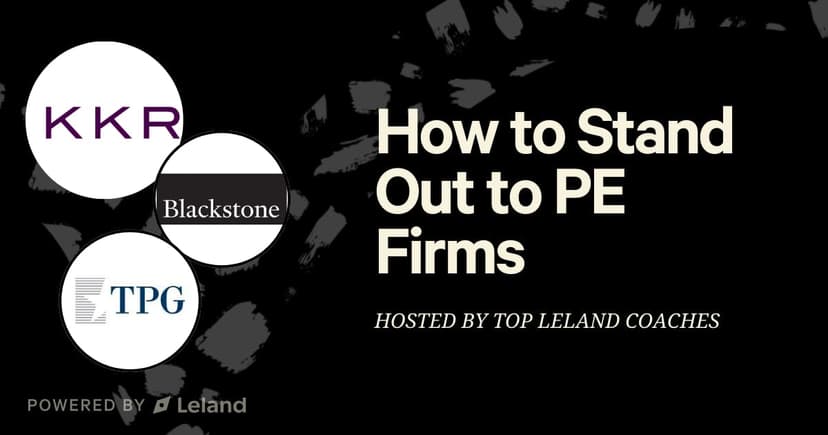Private Equity Case Study Guide: Example & Practice
Break down a real private equity case study step-by-step, with expert insights, example walkthroughs, and tips to sharpen your investment analysis.
Posted August 8, 2025

Join a free event
Learn from top coaches and industry experts in live, interactive sessions you can join for free.
Table of Contents
If you're preparing for private equity interviews, chances are the case study is what’s keeping you up at night, and for good reason. Whether it’s a paper LBO on a whiteboard, a 3-hour modeling sprint, or a take-home assignment with CIM data, the case study is where interviews get real. It’s not just about crunching numbers but proving you can think like an investor.
But most candidates approach the case study like a modeling test, not a decision-making test. They overbuild in Excel, underthink the strategy, and walk into interviews without a framework to fall back on. That’s where this guide comes in.
In this article, we’ll walk through the exact steps top-performing candidates use to tackle private equity case studies, from clarifying the objective to building the model, crafting an investment thesis, and making the final call. You’ll see real examples of what great responses look like (and what weak ones miss), learn expert frameworks to elevate your thinking, and get access to templates and tools used by actual investors.
Read: How to Get Into Private Equity: The Ultimate Guide
What is a Private Equity Case Study?
A private equity case study is one of the most critical and challenging elements of the private equity interview process. It evaluates not just your modeling skills but your ability to think like an investor under time pressure, with limited information and high stakes.
Top private equity firms use case studies to assess whether candidates can structure an investment thesis, identify key drivers of value, and make a high-conviction decision. Beyond spreadsheet accuracy, they're testing how you weigh tradeoffs, assess risk factors, and spot red flags others miss.
A clean financial model won't win you the offer unless it's backed by a compelling investment rationale. Interviewers look for sharp judgment, structured thinking, and the ability to articulate how your thesis holds up under scrutiny, even if the numbers aren’t perfect.
Mega-funds like Blackstone and KKR often test under extreme time constraints with a “Paper LBO.” Middle-market firms might give you a few hours, or even a full take-home exercise to simulate real-world deal analysis, asking for a written investment proposal or memo.
Expert Insight: “It’s not about how pretty your Excel is—it’s about how well you frame risk and reward. Can you defend your logic to an IC partner in five minutes?” – Principal at $5B PE firm, Reddit thread, r/venturecapital
What to Expect
PE case studies vary widely, but most will test three things: your analytical abilities, your strategic thinking, and your ability to communicate a clear final decision under time pressure. Here’s what you can generally expect:
- Paper LBOs (~30 mins): Mental math and structure, no Excel.
- In-office live case (1–3 hours): Model + memo or walkthrough.
- Take-home cases (2–5 days): Realistic CIMs, deeper analysis.
| Type of Firm | Example Firms | What to Expect |
|---|---|---|
| Mega Funds | Blackstone, KKR, Apollo | Fast-paced Paper LBO, minimal guidance, intense pressure. Focus on mental agility, IRR logic, and investment recommendation. |
| Upper Middle-Market | Sycamore, Genstar, Thoma Bravo | Full model + short memo. Emphasis on red flags, operational improvements, and exit assumptions. |
| Growth Equity Firms | Summit Partners, Insight, TCV | More emphasis on revenue growth, product-market fit, and market size. Case studies reflect startup-style risks and upside scenarios. |
| Lower Middle-Market | Shore Capital, Huron Capital | Often customized. May require deep company analysis and focus on operational efficiency or supply chain due diligence. |
Common Private Equity Case Study Prompts for Practice
One of the biggest pitfalls for candidates is walking into a case study without a clear idea of what to expect. While no two firms use the exact same format, most case studies fall into recognizable patterns. Understanding these patterns and practicing the prompts that mirror them can give you a significant edge.
Below are realistic private equity case study prompts, inspired by actual interviews from megafunds, middle-market, and growth equity firms. Each prompt is designed to test a specific skill set: from your investment thesis development and IRR logic to how you handle incomplete data and time pressure.
Expert Tip: Don’t just build a model. Practice your full walkthrough: “Here’s what I saw, what I assumed, how I modeled it, and ultimately, why I’d invest or pass.” That’s what separates top performers from average ones.
Sample Prompts by Category
Paper LBO Prompts - Time-limited; no Excel allowed, test your structure, speed, and logic.
- “You’re evaluating a company with $40M EBITDA and an $8M capex requirement. The sponsor wants to exit in 5 years at the same EV/EBITDA multiple. Walk me through a quick IRR estimate if you can finance the deal with 60% debt.”
- “Given 10 minutes, sketch out a leveraged buyout structure. What’s your assumed debt quantum, interest rate, exit assumptions, and return profile?”
In-Office Live Case Prompts - Expect to model in Excel, build an investment proposal, and present a live thesis.
- “You’re considering a buyout of a specialty chemicals company with flat top-line growth and 15% EBITDA margins. Use the CIM to build a quick LBO model. Based on the output, would you proceed with a bid?”
- “Analyze this business based on its financial statements and produce a 1-page memo covering your investment thesis, top risk factors, and go/no-go decision.”
Take-Home Case Prompts - Longer format; tests independent research, due diligence, and communication.
- “Attached is a CIM and industry report. Build a base case LBO model and submit a 3-page investment memo that includes valuation, growth assumptions, and red flags.”
- “Using public comps and precedent transactions, build a model for this specialty software company. Outline your investment rationale, return profile, and provide at least three key questions you’d ask management.”
Common Case Study Interview Questions
- Would you invest in this company at a $300M enterprise value? Why or why not?
- Build a leveraged buyout model using the following summary financials.
- Draft a 1-page investment thesis based on this CIM.
- What are the key assumptions driving your IRR?
- What potential risks concern you most?
- What would you ask management during due diligence?
These questions test your ability to identify key drivers, assess financial performance, and communicate a well-supported investment recommendation. Use them to shape your preparation.
Types of Private Equity Case Studies
Private equity case studies are more than modeling tests; they’re high-stakes simulations of how you’ll think, decide, and communicate as an investor. The format you encounter depends on the type of firm, the interview stage, and the role, but nearly all fall into one of three buckets: the paper LBO, the full in-office case, or the take-home case. Here’s how each one works, what it reveals to the interviewer, and how top candidates set themselves apart.
Paper LBO
The paper LBO is a rapid-fire logic test designed to see if you understand the core mechanics of a leveraged buyout. You’ll be handed a short prompt—typically with a few key financial figures like EBITDA, purchase multiple, leverage ratio, and holding period—and asked to sketch a simplified LBO model by hand. There’s no Excel involved. You’ll need to calculate IRR and MoM returns quickly, identify how much debt to use, and decide whether you proceed with the deal, all in 20 to 30 minutes.
What It Tests: This format is built to stress-test your mental agility, comfort with numbers, and ability to distill a complex decision into its essential inputs. Interviewers are looking for a strong grasp of return math, clean capital structuring, and clarity in communication. Your ability to simplify assumptions, estimate results confidently, and focus on the core business model is more valuable than producing a mathematically perfect answer. It’s a high-pressure environment that rewards thoughtful judgment over technical polish.
Expert Moves: Top candidates frame their answer clearly and logically: outlining the capital stack, estimating IRR using time-based approximations, and making a defensible go/no-go call. They recognize which assumptions truly drive the outcome—usually entry multiple, leverage, and exit—and make them explicit. Rather than guessing, they explain their reasoning, define a base case, and call out what would change their decision.
How to Prepare: To master the paper LBO, you should run dozens of mental math reps using MoM-to-IRR shortcuts and simplified LBO structures on pen and paper. Practice sketching returns in under 10 minutes while talking through your thought process aloud. Memorize key formulas, know your debt service math cold, and focus on communicating your logic with speed and structure.
Full In-Office Case Study
The full in-office case is the most comprehensive and realistic case format used in private equity interviews. You’ll typically receive a laptop, a confidential information memorandum (CIM) or one-pager, and 1–3 hours to analyze the deal, build an LBO model, and prepare a walkthrough or memo of your findings. This format is common among middle-market and upper-middle-market firms and mimics the actual pace and decision-making of a deal team.
What It Tests: This case format evaluates your ability to prioritize, synthesize, and execute under time pressure. Interviewers want to know if you can focus on what matters: building a functional financial model, identifying key drivers of growth or risk, and translating your analysis into a clear investment thesis. It also reveals your ability to balance speed and depth—whether you can make smart tradeoffs in your modeling without missing critical red flags. Market share assumptions, customer concentration, and operating leverage all become key focal points.
Expert Moves: The best candidates treat the time constraint as an advantage. They narrow their focus to what moves the model—entry and exit multiples, leverage, margin trends—and explicitly flag risky assumptions. They often add basic sensitivity tables to highlight downside cases and include summary outputs that communicate the investment case in under 60 seconds. Their write-ups mirror actual investment committee memos: tight, thesis-driven, and backed by metrics.
How to Prepare: You should build and time yourself on 10–15 mini-case studies that simulate 1–3 hour builds. Start with real CIMs from past deals or publicly traded companies and focus on creating a clean, readable financial model that feeds directly into a short investment memo. Practice your verbal walkthroughs until you can clearly explain your thesis, risks, and valuation logic without notes.
Take-Home Case Study
What It Is: The take-home case study is the most open-ended format—and the one that most closely resembles a real private equity deal process. You’ll be given a CIM or deal packet and asked to return, within a few days, a fully built LBO model and a professional-grade investment memo. This format is common in the later stages of interviews, particularly for growth equity and middle-market firms, where deeper analysis and storytelling are valued.
What It Tests: Firms use take-home cases to evaluate your end-to-end investing process: from market and competitor research to model construction to writing and communication. Unlike time-limited formats, this one tests depth over speed. Can you demonstrate independent thinking? Do you understand how market conditions, competitive dynamics, and operational efficiency impact the outcome? Most importantly, can you distill all of that into a coherent investment recommendation?
Expert Moves: Top-performing candidates mirror the exact structure of an investment committee memo. They begin with a crisp thesis, follow with market dynamics and company positioning, and back up their claim with modeling outputs that clearly show the risk/reward tradeoff. They anticipate objections—such as execution risks, downside drivers, or capital intensity—and address them directly. Their models use realistic inputs based on industry benchmarks and public comps, and their memos are tight, typo-free, and logically structured.
How to Prepare: To prepare effectively, you should complete at least three take-home cases using real CIMs or public company filings. Build a full model with a working three-statement structure, debt schedule, and IRR outputs. Then draft a memo that explains your call in 2–4 pages, following a structured format: thesis, key drivers, valuation summary, risk assessment, and conclusion. Ask yourself: would a senior partner feel confident forwarding your memo to the rest of the IC?
PE Case Study Walkthrough: Step-by-Step
A great case study response is about demonstrating structured thinking, sharp judgment, and the ability to filter noise. This walkthrough mirrors the exact process real investment professionals follow when evaluating a deal. If you can internalize and execute these steps under time pressure, you’ll stand out from 90% of candidates.
Step 1: Clarify the Case Objective and Timeline
Before you touch the numbers or dive into the CIM, get crystal clear on what you’re being asked to do. Are you making an investment decision? At a fixed valuation, or are you determining your bid? Do you need to build a full financial model, sketch a paper LBO, or just frame a verbal recommendation? Is the timeline 30 minutes or three days?
Misinterpreting the assignment is a top reason candidates fail. In a real deal, you’d confirm what kind of investment committee materials are needed and by when, and treat this the same way. Ask clarifying questions if the interviewer hasn’t set boundaries. What are the deliverables? Are you expected to include sensitivities, a downside case, or write a memo? This sets the tone for a focused, professional response.
Step 2: Analyze the Business Model & Key Value Drivers
Once you understand the goal, shift your attention to how the company makes money and whether it’s sustainably positioned in its market. Evaluate the company’s industry, business model, unit economics, and market position. Ask: Is this a product-driven business? Service-heavy? Recurring revenue? High churn? Is revenue volume-driven or margin-driven?
Identify the key drivers that will affect your return. These could include customer acquisition cost (CAC), pricing power, churn rates, cross-sell opportunities, or fixed vs. variable cost leverage. You want to quickly frame what’s actually moving the needle. Anchor your investment logic to these drivers as they’ll feed directly into your investment thesis, your growth assumptions, and your sensitivity analysis.
Step 3: Build or Sketch the LBO Model
Now it’s time to quantify your assumptions and estimate returns. Your model doesn’t need to be overly complex, but it must be accurate and defensible. Start with the entry price, usually a purchase multiple on LTM EBITDA, and construct the capital structure based on reasonable leverage ratios. Estimate interest expense, build out a 3–5 year projection with revenue growth and margin expansion (if justified), and model out cash flow to support debt repayment.
Ensure your income statement, cash flow statement, and balance sheet are logically integrated. Your output should clearly show IRR and MoM returns, plus any downside sensitivities. Even in a paper LBO, structure matters: show that you understand where value comes from, and how small assumption changes affect returns. Real PE teams expect a tight, clean financial model that reflects good judgment and ties directly into the recommendations, not just Excel fluency.
Step 4: Assess Risks, Assumptions, and Exit Options
This is where strong candidates separate themselves. Think like an investor managing a portfolio. What are the risk factors that could derail your thesis? Are you assuming an aggressive margin profile in a commoditized industry? Overlooking execution risks, regulatory pressure, or operational inefficiencies? Be the person who sees what others miss.
Frame your exit assumptions carefully. Who might acquire this company? What’s a reasonable multiple? Will the sponsor need to improve the core business, consolidate market share, or reduce costs to hit the return target? Consider external factors like economic cycles or supplier dependencies. Good candidates list risks; great ones size them, stress-test them, and proactively account for potential outcomes in the model and memo.
Step 5: Decide – Invest or Pass?
Here’s the moment that matters. Would you do the deal or walk away? Back your decision with a structured argument, not gut feel. The best way to do this is with a three-part framework: summarize the investment thesis, assess financial performance and returns, then articulate the key risks that could make or break the deal.
Don’t hedge your answer or try to impress by staying neutral because firms want to see you take a position. Be confident, but not arrogant. If you would pass, explain why. If you would invest, support it with clear logic and numbers. Demonstrate that you understand not just how to model, but how to make capital allocation decisions. That’s what real investors do every day.
Example Private Equity Case Study
To illustrate what separates a strong case study from a weak one, here are two contrasting examples based on real case logic and evaluation criteria used in top-tier private equity interviews. The first demonstrates how to synthesize a clear thesis, model conservatively, and evaluate red flags. The second shows what happens when optimistic assumptions and weak analysis go unchecked.
Case 1: Strong Example — HVAC Services Roll-Up
Target Overview: A regional HVAC services company pursuing an acquisition-driven growth strategy across the Midwest. The business generates $75 million in revenue and $12 million in EBITDA, with an 8% CAGR over the past three years. Customer contracts are largely recurring, and margins are stable.
Investment Thesis: The candidate articulated a compelling, three-pronged thesis:
- Highly recurring revenue with low churn
- Fragmented market ripe for consolidation
- Clear add-on acquisition potential to drive operating leverage and scale
The thesis was anchored in market realities—supported by data on local competition, regulatory tailwinds, and long-term HVAC demand. The candidate also addressed execution requirements, including integration and technician onboarding.
Model Assumptions: The LBO model used a 9x entry multiple and 5.5x leverage, both within realistic industry benchmarks. Forecasted modest revenue growth and 100bps margin expansion based on modest pricing power and cost optimization. IRR was projected at 23%, with a 2.5x MoM return over a 5-year hold, using conservative exit assumptions.
Risk Evaluation: The analysis acknowledged two critical risk factors: technician retention (in a labor-constrained trade) and supplier concentration. The candidate discussed mitigants, such as equity incentives for field teams and long-term vendor agreements.
Outcome: The recommendation was to invest, contingent on confirming assumptions in management Q&A and site diligence. The memo clearly linked qualitative upside to quantified returns and demonstrated a thoughtful, risk-aware approach.
Why It Works: This case study stood out because it paired realistic modeling with sharp judgment. The financial model is tied directly to the thesis. Red flags were surfaced early, not ignored. And the conclusion reflected mature decision-making, balancing upside with realistic downside scenarios. It mirrored how a real associate would prepare for the investment committee.
Case 2: Weak Example — Online Mattress Retailer
Target Overview: An e-commerce mattress company with $120 million in revenue and 3% EBITDA margins. Growth had plateaued, and customer acquisition costs were rising. Despite being in a trendy sector, the business lacked pricing power and brand loyalty.
Investment Thesis: The candidate framed the deal around an “explosive market opportunity” and a “high-growth DTC space.” However, no concrete key drivers were articulated. The thesis lacked structure, and the analysis relied on vague market optimism rather than fundamentals.
Model Structure: The candidate used a 10x entry multiple and 6x leverage, which are aggressive assumptions given the flat revenue and low margins. Projected IRR was 28%, but it hinged on unrealistic revenue growth, steep margin expansion, and a rich exit multiple. There was no downside case or sensitivity tables included.
Risk Blind Spots: Critical issues were ignored: negative cash flow, high churn, customer concentration, and an unsustainable CAC-to-LTV ratio. The candidate failed to recognize that this was not a buyout-ready business; it was a venture-backed growth company with a risky profile.
Outcome: Despite all red flags, the candidate recommended investing—without caveats or diligence priorities. The recommendation felt rushed and unbalanced.
Why It Fails: This case missed the mark because it relied on hope over discipline. The model was optimistic, the thesis was shallow, and the candidate failed to ask tough questions. There was no clear grasp of the financial statements, no plan for operational improvements, and no coherent path to returns. It read more like a pitch deck than an investment committee memo.
Key Takeaway: Great candidates don’t just model returns but also interrogate assumptions. They frame upside and downside with clarity, tie numbers to strategy, and show professional skepticism. That’s what makes an investment memo sound like it was written by someone ready to step into the role on day one
Case Study Common Mistakes
Even strong candidates get tripped up by avoidable errors that signal inexperience or lack of investor intuition. Below are the four most common and most costly mistakes that show up in private equity case study interviews. Understanding these will help you prepare like an insider and stand out for the right reasons.
You overengineer the model and miss the bigger picture
One of the biggest traps candidates fall into is building a flawless, hyper-detailed model and completely failing to explain why the deal is attractive. Excel perfection doesn’t matter if you can’t articulate a clear investment thesis. Interviewers aren’t impressed by five-tab cap tables or macros; they’re looking for structured thinking. Your model is a tool to support a decision, not the decision itself. If you can’t summarize the deal’s upside in 60 seconds, you’re already losing the room.
You make unrealistic assumptions
Many candidates shoot themselves in the foot with overly aggressive assumptions that instantly kill credibility. Forecasting 25% revenue growth in a commoditized industry, applying 7x leverage to a niche services company, or assuming perpetual multiple expansion with no justification—these are red flags. Good investors know the industry benchmarks. When your model ignores market realities, the conclusion doesn’t matter. It shows that you haven’t done the work to understand market dynamics, execution risk, or capital structure norms.
You fail to articulate the investment thesis clearly
Even if your model is technically correct, if your case memo or verbal pitch is vague, unfocused, or buzzword-heavy, it will fall flat. A strong case study is rooted in 1–2 clear value creation levers—like pricing power, margin expansion, or consolidation upside. If your thesis sounds generic or lacks supporting data on the company’s industry, market share, or growth potential, it suggests you’re operating at the surface level. Great candidates connect strategy to numbers and frame tradeoffs with conviction.
You underestimate exit planning or downside risk
Private equity firms are laser-focused on the exit from day one. Candidates who ignore exit options, overestimate multiple expansion, or fail to identify major risk factors undermine their own credibility. Whether it’s customer concentration, regulatory exposure, or operational inefficiencies, you need to show mature skepticism. A good case doesn’t just highlight upside, it stress-tests potential outcomes if things go wrong. Smart interviewers reward candidates who proactively address external factors and outline clear exit assumptions based on realistic comparables.
What Poor vs. Great Case Responses Look Like
| Dimension | Poor Response | Great Response |
|---|---|---|
| Investment Thesis | Vague or generic (e.g., “high growth market,” “strong management”) with no clear drivers or strategic rationale. | Anchored in 1–2 compelling value levers (e.g., pricing power, margin expansion, acquisition roll-up) and clearly linked to market data and the company’s core business. |
| Modeling Assumptions | Aggressive and unjustified (e.g., 25% CAGR in a mature sector, 7x leverage in healthcare, 3-turn exit multiple expansion). | Calibrated based on industry benchmarks and historical comps. Shows understanding of tradeoffs in capital structure, margins, and growth assumptions. |
| Financial Model Structure | Overbuilt or disorganized model with excessive complexity, circular references, or incomplete outputs. | Streamlined model focused on essentials: clean 3-statement flow, functional LBO model, clear IRR/MoM outputs, sensitivity tables for key drivers. |
| Risk Assessment | Ignores red flags (e.g., customer concentration, churn, cyclicality) or brushes off risks with hand-waving optimism. | Identifies specific risk factors, sizes their impact, and suggests mitigants. Incorporates downside scenarios and thinks critically about execution risks and macro trends. |
| Exit Assumptions | Assumes multiple expansion or an ideal buyer without justification. No exit logic or realistic pathway articulated. | Thoughtful exit assumptions tied to strategic buyers, public comps, or market cycles. Explains potential outcomes based on base and bear cases. |
| Use of Market Data | No use of market dynamics, competitive context, or TAM sizing. Treats the company in a vacuum. | Integrates market share, growth drivers, and industry trends to validate thesis and growth assumptions. Grounds valuation in public comps or precedent transactions. |
| Clarity of Communication | Jargon-heavy, disorganized, or overly verbose memo. Misses key sections like thesis, risks, or recommendations. | Crisp memo or verbal walkthrough with clear structure: investment thesis, value creation, risks, and investment recommendation. Executive-ready presentation quality. |
| Decision-Making | Hedging, indecisive, or overly optimistic. Avoids making a call or leaning on return metrics without strategic context. | Takes a clear position to invest or pass, backed by logic, model outputs, and thoughtful scenario planning. Sounds like a real investor, not just a technician. |
| Due Diligence Questions | No questions or shallow ones (e.g., “Can I get the forecast model?”). Doesn’t engage like an owner. | Asks sharp, forward-thinking questions (e.g., “What percentage of EBITDA is tied to the top 5 customers?” or “What’s the customer retention by segment?”). Shows strategic insight. |
| Overall Impression | Feels like an analyst trying to impress with modeling. Missing investor mindset. | Feels like an associate ready to defend a deal to the investment committee. Combines analytical skills with judgment, skepticism, and business intuition. |
Expert Insight: Private equity firms don’t hire spreadsheet wizards; they hire future investors. The best case responses reflect mature thinking, not just technical ability. Your ability to connect strategy, risk, and return is what ultimately converts interviews into offers.
Common Private Equity Case Study Interview Questions (and How to Answer Them)
Private equity case study interviews test more than your ability to build a clean model; they probe how you think about capital allocation, risk, value creation, and deal judgment under pressure. The best candidates don't just answer the question; they reveal investor-level thinking in how they frame it.
Here are five of the most common case study questions, along with expert strategies for delivering responses that resonate with deal professionals.
1. “Would you invest in this company?”
What They're Really Asking: Can you take a clear position, back it up with logic, and present a decision the firm could actually act on?
How to Answer Like a Pro: Avoid a simple “yes” or “no.” Instead, structure your answer around your investment thesis, supporting metrics (IRR, MoM, leverage, margins), and a summary of key risks. Demonstrate balance by acknowledging both upside and downside drivers. If you’d walk away, explain why, without sounding risk-averse. If you’d invest, explain under what conditions.
Pro Tip: Use a 3-part framework: Thesis → Key Drivers → Red Flags → Final Call.
2. “What are the biggest risks in this investment?”
What They're Really Asking: Have you done the work to surface deal-killers? Can you size them and think about mitigation?
How to Answer Like a Pro: Don’t just list generic risks. Tie each risk factor to your model’s core assumptions. For example:
- Customer concentration - threatens revenue stability
- High capex requirements - pressure on cash flow and debt service
- Aggressive exit multiple - downside IRR compression
Then, show how you’d size and mitigate each risk (e.g., structuring earnouts, running sensitivity analysis, or probing in management Q&A).
Pro Tip: Prioritize 2–3 meaningful risks. Be specific. Be proactive.
3. “Walk me through your valuation and IRR analysis.”
What They're Really Asking: Do you understand what drives value in a leveraged buyout, and can you defend your assumptions?
How to Answer Like a Pro: Start with your entry multiple and explain how it was derived (public comps, transaction comps, historical precedent). Walk through the capital structure, debt assumptions, revenue/EBITDA projections, and exit assumptions. Then link it to your return profile, like IRR and MoM, and highlight what your sensitivities revealed.
Pro Tip: Always tie your valuation logic to industry benchmarks, not wishful thinking.
4. “What would you ask the management team?”
What They're Really Asking: Are you thinking like a real investor conducting diligence or like a candidate checking boxes?
How to Answer Like a Pro: Focus on questions that validate or challenge your assumptions. Examples:
- “What’s the real churn rate by customer segment?”
- “What are your organic vs. acquisition growth targets?”
- “What’s the plan for margin expansion—cost-cutting or pricing power?”
Your questions should fill in the blanks of your model or thesis—not just show curiosity.
Pro Tip: This is your chance to surface uncertainty in your case—and show how you'd resolve it through thorough due diligence.
5. “What could break your investment thesis?”
What They're Really Asking: Can you anticipate downside scenarios and build resilient thinking?
How to Answer Like a Pro: Start by reaffirming your thesis, then walk through one or two potential outcomes where it might break down. For example:
- Price pressure in a low-moat industry
- Talent loss is driving operational underperformance
- Failure to integrate add-on acquisitions
Then explain how you modeled or accounted for this risk, either in sensitivities, debt sizing, or valuation conservatism.
Pro Tip: This is not a weakness; it’s a strength. Good investors always ask: “What has to go right for this deal to work?”
Questions to Ask During a PE Case Study (Like a Real Investor)
One of the most overlooked parts of private equity case study prep is learning how to ask the right questions. In real deals, what you ask the management team is often more revealing than the model itself. Great candidates use this part of the interview to showcase strategic insight, diligence instincts, and the ability to identify risk factors that others miss.
How to Think About It
After reviewing the CIM or case materials, ask yourself:
- What assumptions am I making that haven’t been validated?
- What could cause this deal to fail?
- Where do I lack visibility?
Then, structure your questions to either de-risk your thesis or deepen your conviction.
Smart, Insightful Questions to Ask in a PE Case Study
1. Revenue Drivers & Growth Quality
“What are the top 2–3 factors driving revenue growth today? Are they volume, pricing, or mix-driven?”
This helps you test the durability of the growth trajectory. If it’s pricing-driven in a commoditized space, that’s riskier than recurring volume growth with high retention.
2. Customer or Revenue Concentration
“How much revenue comes from your top 5 customers, and how has that changed over time?”
This gets at market concentration risk, switching costs, and potential vulnerability in a downturn. A deal with 30% revenue from one client may be structurally uninvestable.
3. Churn and Net Retention
“What’s your annual customer churn, and what does net dollar retention look like?”
Churn rates directly impact your cash flow, LTV, and ability to model sustainable financial performance. In a SaaS or recurring revenue deal, this question is critical.
4. Margin and Operational Efficiency
“What specific initiatives are in place to improve gross margin or SG&A leverage over the next 12–24 months?”
This shows you’re thinking like an owner who plans to drive operational improvements. It also highlights whether the team is execution-oriented or not.
5. Competitive Positioning
“Where do you see the most aggressive competition, and what’s your differentiation beyond price?”
This helps you understand market dynamics, pricing pressure, and whether the business is truly defensible, especially relevant for growth equity deals or crowded verticals.
6. Capital Intensity & Capex Requirements
“What level of maintenance vs. growth capex is required to support the current plan?”
Capex assumptions have a direct effect on your cash flow, debt paydown, and return profile. Clarifying this lets you refine your IRR inputs and test exit viability.
7. Talent Risk & Execution
“Which roles or people are critical to the company’s success, and how do you retain them?”
This shows attention to execution risks and cultural fit. It’s also a proxy for how scalable the business is, or how founder-dependent it might be.
Expert Advice: What Frameworks, Models, and Resources to Use
Top private equity candidates don’t just build clean models—they develop repeatable systems for structuring judgment, organizing information, and communicating like an investor. Here’s how to prepare like a professional: what to memorize cold, what to flex based on the deal, and what resources elite candidates use behind the scenes.
Core LBO Model Structure: What to Memorize vs. What to Flex
A strong LBO model is the backbone of any private equity case study. But knowing what to build and how much detail to include can make or break your interview.
What to memorize cold: You should be able to build a simplified LBO model from scratch in under an hour. That includes purchase price calculation, sources and uses, debt schedule, interest expense, free cash flow projection, IRR/MoM outputs, and basic exit assumptions. You must also know debt repayment logic, depreciation tax shields, and the impact of working capital changes without needing to think.
What to flex depending on the case: In a timed case or take-home, skip the bells and whistles. Add a working capital schedule or multiple tranches of debt only if it’s relevant. What’s more important is the flow: your income statement, cash flow statement, and balance sheet should speak to each other cleanly. Your Excel doesn’t need to be fancy—it needs to be defensible.
Qualitative Frameworks That Actually Work in PE
While private equity is numbers-heavy, the best candidates pair their modeling with clear strategic thinking. This is where qualitative frameworks shine—if you know how to apply them in an investor context.
- Porter’s Five Forces with a PE lens: Don’t just list the forces. Ask: How will bargaining power affect EBITDA margins? Will barriers to entry protect pricing power post-acquisition? What’s the impact on IRR?
- Value Chain Analysis: Can the sponsor drive operational efficiency by cutting costs, verticalizing supply, or reworking distribution?
- Growth Opportunity Mapping: Where is the growth potential—organic vs. acquisition? New markets vs. new products? What’s proven vs. speculative?
- Downside Framing: Use a framework to define execution risks, margin pressure, and macro external factors. Think like an IC partner asking: “How do we lose money on this deal?”
Expert Insight: You’re not trying to sound like a consultant. You’re trying to sound like a deal professional who sees both value and risk—and can frame both clearly.
Must-Have Resources Every Top Candidate Uses
The best prep doesn’t just come from guides—it comes from real materials used in the deal world. Here’s what to have on hand:
- CIM Templates and Case Packs: Use real or anonymized CIMs from previous deals to practice parsing business models, financials, and red flags. Pay attention to what’s missing—because that’s what your follow-up questions should target.
- Investor Presentations and 10-Ks: Public filings and investor decks are treasure troves for understanding how real companies pitch their value proposition. Use them to build reps identifying the company’s offerings, market dynamics, and operating risks.
- Data Sources for Assumptions: Build assumptions using real public comps, IBISWorld/Statista/CapIQ data (if available), and precedent transactions. This will calibrate your model to industry benchmarks, something every interviewer will be silently checking.
- Interview Feedback Threads (e.g., Reddit): Threads like this one offer uncensored takes from candidates who’ve been in the room. Pay attention to what actually got tested, and what interviewers cared about.
Explore: The Best Venture Capital & Private Equity Newsletters and Podcasts
Want to Master It All, Fast?
If you’re serious about breaking into private equity, consider joining a Private Equity Recruiting Bootcamp and Free Events. You'll get hands-on experience building LBOs, simulating case walkthroughs, refining your investment recommendation, and learning how top private equity firms provide feedback on candidate performance. These crash courses replicate the full interview process, from paper LBO to take-home memo, so you walk in with confidence and investor-level preparation.
Final Word: What Sets Top Candidates Apart
When it comes down to offer decisions, private equity firms are choosing the one they trust to sit in a deal room, challenge assumptions, and make real investment decisions. Top candidates don’t act like junior analysts; they behave like future deal team members. They bring structured thinking, mature skepticism, and business intuition to every case.
They think like investors. That means they don’t just build models—they pressure-test them. They understand where the numbers come from, which assumptions drive returns, and how to tie financial outputs to real-world business levers.
They communicate clearly under pressure. Whether walking through a paper LBO in 10 minutes or defending a take-home memo in front of a VP, they structure their thinking crisply. Their logic flows. Their confidence doesn’t come from memorization—it comes from reps and rigor.
They ask the right questions. In live case interviews, standout candidates probe the CIM like they’re preparing for management Q&A. They surface hidden risk factors, challenge unrealistic projections, and flag the 1–2 red flags that would kill the deal.
Above all, they show mature skepticism. Instead of selling the deal, they evaluate it, acknowledging both upside and downside with intellectual honesty. They don’t rely on enthusiasm to mask weak logic. They know that in private equity, capital is precious—and conviction must be earned.
Ace Your PE Case Study Interviews With the Help of an Expert
Struggling to craft a convincing investment thesis or build a clean, defensible financial model under pressure? You’re not alone. Work 1:1 with a top private equity coach who’s aced top private equity firm interviews and knows what separates good from great.
Whether you need help with memo formatting, case walkthroughs, or simulating the interview process, a coach can help you turn your prep into a top-tier offer. Browse top private equity coaches here.
See: The 10 Best Private Equity Career Coaches for Interview Prep & Training
Not sure what coach is right for you? Check out this Private Equity Interview Prep package – choose your price and we’ll custom match you to the best expert for your background, goals, and budget.
Read these next:
- Private Equity Resume Guide (With Template & Example)
- The 50 Most Common Private Equity Interview Questions
- 20+ Second-Round Interview Questions You Need to Know
- 25+ Questions To Ask At a Career Fair
- Top Private Equity Internship Programs (and How to Stand Out)
- Finance Internships for College & High School Students
- Private Equity Roles: The Different Career Paths
FAQs
How hard is a private equity case study?
- Extremely. It tests both modeling accuracy and investor-level judgment under time constraints.
What do interviewers look for in a private equity case study interview?
- Sound logic, a clear investment proposal, and awareness of risk factors and market dynamics.
What’s the best way to structure my answer in a PE case study?
- Use the classic memo: thesis, value drivers, red flags, IRR summary, final decision.
Do I need to be an Excel expert to pass a PE case study?
- No, but you must be fluent in LBO logic, assumptions, and clean formatting under pressure.
How do I prepare for a private equity case study interview?
- Practice 10–15 case studies, simulate real timers, get feedback, and work with an expert to hone your edge.
Browse hundreds of expert coaches
Leland coaches have helped thousands of people achieve their goals. A dedicated mentor can make all the difference.
















